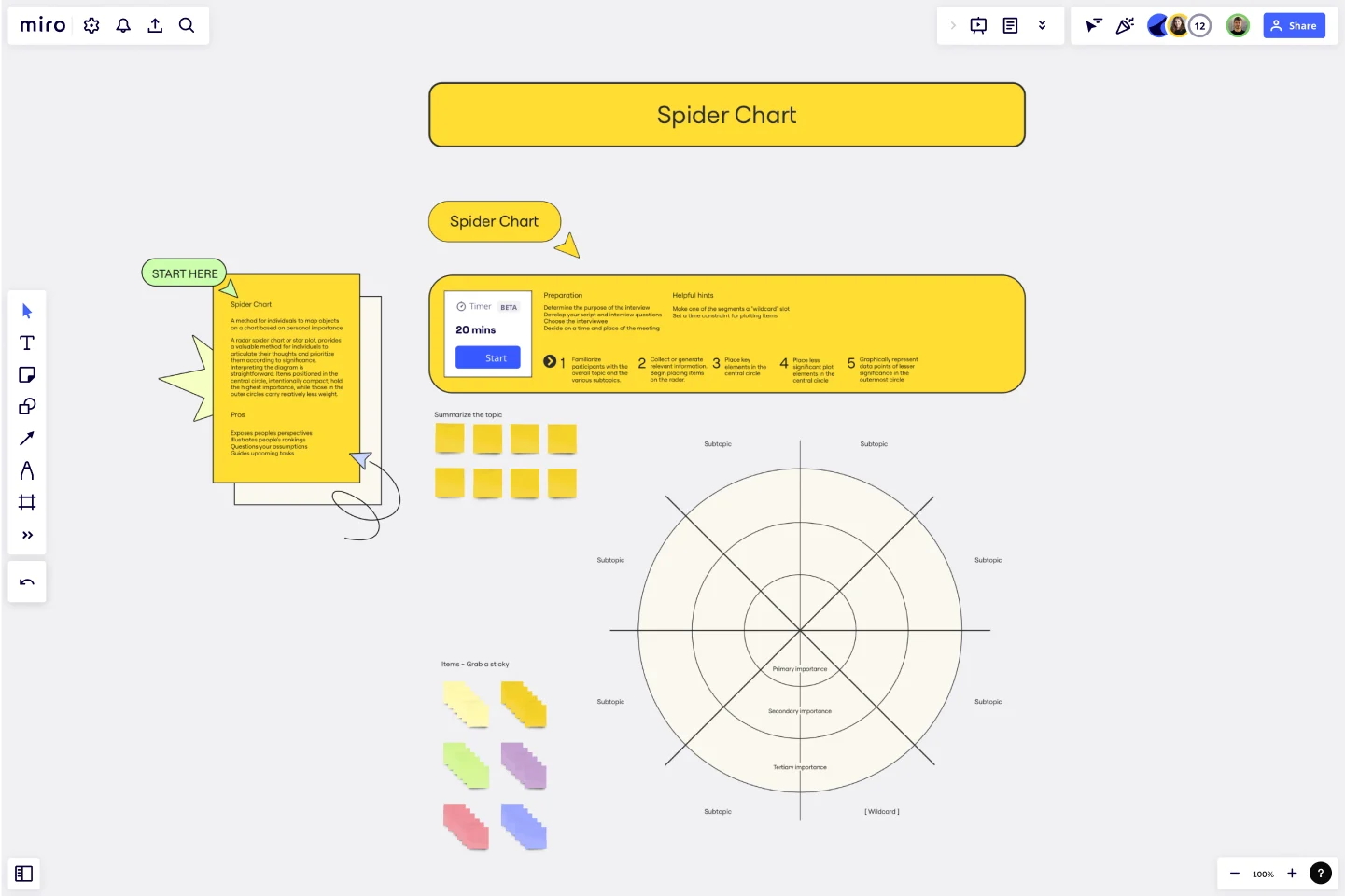Spider Chart Template
Map objects on a chart based on personal importance with the Spider Chart Template.
About the Spider Chart Template
The Spider Charts, also known as star plots, present an effective way for people to express their thoughts and ideas while prioritizing them based on their relative importance.
This type of diagram is valuable when dealing with complex information, as it allows for a clear visualization of the most significant items positioned in the central circle. Meanwhile, less important items are placed in the outer circles, which are progressively farther from the center. By using a radar spider chart, people can better understand the relationships between different pieces of information and make more informed decisions.
Benefits of using the Spider Chart Template
Expose people's perspectives.
Illustrate people's rankings.
Question your assumptions.
Guide upcoming tasks.
How to use the template in Miro
Familiarize participants with the overall topic and the various subtopics.
Collect or generate relevant information. Begin placing items on the radar.
Place key elements in the central circle.
Place less significant plot elements in the central circle.
Graphically represent data points of lesser significance in the outermost circle.
Setup
Determine the purpose of the interview.
Develop your script and interview questions.
Choose the interviewee.
Decide on a time and place of the meeting.
Useful tips
Make one of the segments a "wildcard" slot.
Set a time constraint for plotting items.
Get started with this template right now.
Empathy Map [Research]
Works best for:
Market Research, Research & Design
Empathy Map Research template helps you gather in-depth user insights. It’s designed for teams who want to understand user behaviors and needs better. Use this template to inform your design decisions and create user-centered products.
Discovery Interviews Template
Works best for:
Design, UX
The Discovery Interviews Template is a powerful tool that allows you to delve into a topic from different angles and gain a deeper understanding of different perspectives. By conducting interviews using this template, you can uncover valuable insights and uncover new information that can help you make informed decisions. Whether you are a researcher, product manager, or simply curious about a specific topic, the Discovery Interviews Template is an essential resource for anyone looking to explore a subject in depth.
Collaborative Prototyping Template
Rapid prototyping quickly tests concepts and solutions with low-fidelity functional models, reducing investments by identifying issues early. The Collaborative Prototyping Template generates ideas and tests them with a framework for sharing prototypes and getting feedback.
Co-Creation Template
Works best for:
Design
The Co-Creation Template enables the visual expression of ideas using essential elements. Analysis of these creations identifies explicit and implicit needs. For instance, a human resources team may use symbols to envision their ideal work environment. The output reflects people's desires and expectations.
Storyboarding Template
The Storyboarding Template is an excellent way to visualize how people will experience your concept in action. It primarily consists of images, which enable teams to communicate ideas with greater clarity and emotional impact than words alone. You don't need exceptional artistic skill to create storyboards; you simply need to depict a meaningful sequence of events.
Empathy Map by Medicenjuande
Works best for:
Market Research, Research & Design
Empathy Map template provides a clear way to visualize user insights. By understanding what users think, feel, and experience, you can design products that truly resonate. This template is perfect for UX teams focused on user-centered design.
